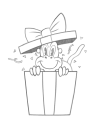
Overview
If you want realism in your work, you need to master seeing values and controlling your medium. That’s what the next few assignments are about. With the Value Gradient, Value Couplet, and Value Scale, the specific skills you will develop are value control, edge control and the ability to create smooth tones. This is extremely useful in realistic drawing! It allows you to create a convincing illusion of form and resolve many drawing problems.
You can do one Value Gradient for each medium you work in. It’s ideal to do it when you first encounter a new medium, but it’s helpful at any skill level. Many experienced artists still practice Value Gradients to maintain their craftsmanship. If it’s good enough for them, it’s surely good enough for us!
Materials
- A soft pencil for dark tones. I like a 2B. If you want to go darker, you can use a 3B or 4B. But be mindful that softer pencils produce more sheen. To avoid this, you might try a Staedtler Mars Lumograph pencil or a Faber Castell Pitt Graphite Matt.
- A hard pencil for light tones. I like a 2H. If you only have an HB or H, they will work as well.
- A kneadable eraser and/or a mechanical eraser.
- A ruler. You can also use the edge of a book.
- A piece of paper. You need a proper drawing paper, around 160 gsm (98 lb). Canson Mi-Teintes, Fabriano Roma, or Arches work well.
Duration
This project should take between 30 minutes and 3 hours to complete. The time depends on your experience level with your medium. Do not rush through the value assignments. If you are pressed for time, focus on the Value Gradient first, then Value Couplets.
Things to keep in mind
- If you work carefully and with clean hands, you will finish much quicker than trying to rush.
- Keep “cleaning up” your gradient as you work, so it is free of texture/noise, and you can see the values clearly.
- This will take time. Expect to invest at least 1 hour.
Steps
1) Draw a box
Use light lines to indicate the shape of your gradient.

2) Start with the dark extreme
Place your “darkest dark” on the left side of your gradient. The far right represents your “lightest light”, the paper value.

3) Establish a rough gradient
Grow out from black towards the middle value and establish a gradient. Keep your tone fairly clean/even. Is the gradation well-balanced overall?

4) Refine
Clean up the tones to make a smooth transition from left to right.

5) Finish
Finish the scale by sharpening the contour and evening out any irregularities. This can take a while! Be patient and really go for perfection.

Common Mistakes
1) Noise
❌ Do not rush and create a messy tone because it will limit how clearly you see the values.✅ Do create smooth tones. Here’s an article on how to do this.

2) Out of Balance
❌ Do not make the gradient too dark or too light overall.✅ Do keep it balanced.

3) Dark Outline
❌ Do not draw a dark or thick outline around the gradient. It’s distracting.✅ Do draw a subtle outline around the contour. This helps separate the light tones from the paper.

Successful Examples


How to Create Smooth Tones
Make sure to also read this article: www.dorian-iten.com/smooth-tones
